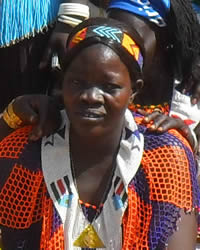Ma'adi in South Sudan

Photo Source:
Rafiki Theatre - Wikimedia
Creative Commons
|
Send Joshua Project a map of this people group.
|
| People Name: | Ma'adi |
| Country: | South Sudan |
| 10/40 Window: | No |
| Population: | 33,000 |
| World Population: | 432,500 |
| Primary Language: | Ma'di |
| Primary Religion: | Christianity |
| Christian Adherents: | 86.00 % |
| Evangelicals: | 12.00 % |
| Scripture: | New Testament |
| Ministry Resources: | Yes |
| Jesus Film: | Yes |
| Audio Recordings: | Yes |
| People Cluster: | Sudanic |
| Affinity Bloc: | Sub-Saharan Peoples |
| Progress Level: |
|
Introduction / History
The Ma'adi people live along both sides of the White Nile from Rhino Camp in Northern Uganda northward across the South Sudan border to a point about halfway to Juba. The great majority live in Uganda, many came from South Sudan originally. They are now only a part of what used to be a large group stretching westward some distance across the Democratic Republic of Congo and northward on a parallel with Juba and Maridi. Several of the related groups, such as Kaliko and Lugbara, still recognize themselves as Ma'adi and call their languages "Ma'di Ti", although they are now separated and their languages are no longer the same.
What Are Their Lives Like?
Ma'adis are primarily farmers and fishermen. They used to do more hunting and trapping, but there is very little game left in their area. They are industrious and even when the Ugandan Ma'adi have been refugees in what was then Sudan (during the 80s) or the Sudanese have been refugees in Uganda (during the 90s), they have done well in raising enough food. However, they have lacked many other things. Many Ma'adi have sought education, and they are eager to progress. However, their remoteness and the displacements of wars have meant that they have had little opportunity for advancement, except by leaving their communities. Some are found in Kampala, Nairobi, Juba, and even Khartoum.
What Are Their Beliefs?
The Ma'adis are mostly Christian, but their faith is hampered by traditional religion, which gives them faith in the spirit world.
What Are Their Needs?
Their language has been written 70 years, and the New Testament published in 1977; however, it is unreadable, except for those who already know what it says. The reason is that the language is so tonal that words can have as many as five different meanings, depending upon the tones; but tone, and other vowel qualities have been ignored in the orthography. A language committee has now decided to adopt tone marks into the orthography, and work on the new orthography is underway.
Prayer Points
Pray that soon they will become Christ's ambassadors to disciple less-reached nations.Pray for the Lord to bless Ma'adi Christian believers with an abundance of God's love, joy, and kindness, drawing others to the King of kings.Pray for them to be grateful for God's spiritual and physical provisions.Pray for the Holy Spirit to move powerfully in such a way that they will become a light to those who still lack a relationship with Jesus Christ.